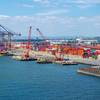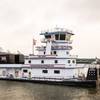The USCG announced measures to prevent environmental and health problems resulting from harmful aquatic plants and animals carried from abroad in ships' ballast water, a move reflecting the Department of Transportation's commitment to controlling and preventing the introduction of these species.
A new interim rule, effective July 1, requires ships operating outside of U.S. waters to report their ballast water management practices. It also establishes voluntary ballast water management guidelines for all waters of the U.S. The USCG is taking these actions to implement the National Invasive Species Act (NISA) of 1996.
Current federal regulations require ships entering the Great Lakes and upper portions of the Hudson River to conduct an open-ocean exchange of their ballast water prior to using these waterways. During this procedure a ship replaces the water in its ballast tanks with water that is less likely to contain potentially invasive species. This is currently defined as water from a sea area over 200 miles from shore and with a depth of 6,561 ft. This operational process has drawbacks, including ship safety concerns, but it is the best solution available at the moment.
The interim rule requires a ship with ballast tanks, after having operated beyond the 200-mile-wide Exclusive Economic Zone, to provide information that documents the ship's ballast water management efforts. This information will be collected by the USCG and entered into the National Ballast Water Information Clearinghouse (NBIC) database. The NBIC database will aid the USCG and other interested parties in identifying the patterns of ballast water management and delivery in waters of the U.S.
The regulations and guidelines in this rule implement voluntary national guidelines of NISA and will help control the spread of invasive species by:
· Promoting ballast water management for operators of all ships in all U.S. waters;
· Recommending voluntary ballast water management guidelines for operators of ships entering U.S. waters after having operated beyond the 200-mile-wide Exclusive Economic Zone; and
· Requiring operators of ships entering U.S. waters, after having operated beyond the Exclusive Economic Zone, to submit a ballast water management report to the Coast Guard.
Aquatic nuisance species invasion through ballast water is recognized as a serious problem threatening global biological diversity and human health. One of the primary pathways for the introduction and spread of nonindigenous aquatic species is a ship's ballast water.
A few of the aquatic species that have had the most dramatic invasive impacts in recent years include zebra mussels, which invaded the Great Lakes in 1986; Asian clams, which disrupt the food chain of northern San Francisco Bay; hydrilla, an aquatic plant that clogs waterways in 40 states; and purple loosestrife, another aquatic plant that has invaded 40 states where it displaces native vegetation and disrupts ecosystems.
Sponsored Content
Lower carbon intensity fuels to support your operations

Subscribe for
Maritime Reporter E-News
Maritime Reporter E-News is the maritime industry's largest circulation and most authoritative ENews Service, delivered to your Email five times per week










